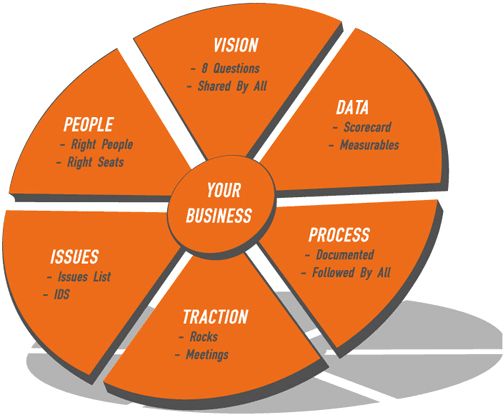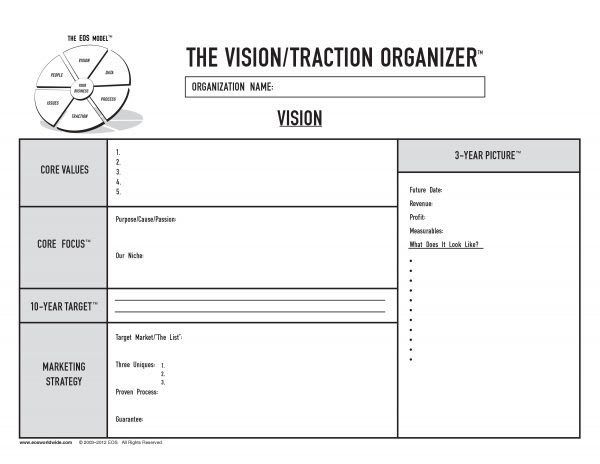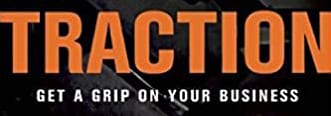For those of you who don't know, in my free time I really enjoy reading two things:
- Management books
- Roleplaying books
Surprisingly, they're actually very similar types of content! We explored this a bit in my last post Dungeon Master to Dev Manager. Both types of book offer the reader a system of thinking, a way to view the world. Good management books give you a new lens with which to view and address most problems rather than just a tool to address a specific problem.
Traction, by Gino Wickman introduces us to the Entrepreneurial Operating System (EOS), a complete top-to-bottom paradigm for running your business. The book pulls a lot from other well respected books and pairs those with Wickman's many years of experience helping businesses succeed to give you a complete system to run your entire business.
Overall, I would give Traction 4.5/5 stars! Here at Volusion we've started using it as the main system across our business, and the effect has been staggering. It's brought alignment in both our cultural values and our business goals from the leadership team to every employee. If you want a one stop shop to define everything you need for your business, look no further!
Let's talk about some of the highlights!
What is EOS
EOS is made up of 6 main components:
Vision
People
Data
Issues
Process
Traction
In the book, each of these components gets an entire chapter dedicated to the systems involved and the nuances of implementing it. Similar to roleplaying books, Traction is like the core book. You can learn everything you need to effectively use it with this single book. However, for anyone who wants to dig in more, EOS has an entire library of books to help you learn more and implement EOS in the best way for your company.
Wickman calls this system an Operating System for good reason. It's very specific and breaks every part of your process down in a way that can be understood within this system. As a developer, having such a clearly defined API for interacting with the business is incredible!
Let's talk a bit more about those components!
Vision
Vision is the first (and possibly most important) component to get clarity on. EOS uses what's called the Vision/Traction Organizer to consolidate all of the core ideas of your company in a way that anyone can understand at a glance. It includes your core values, issues, niche, mission statement, and even short and long term goals!
Just being forced to write all of these things down on paper is incredibly powerful. It's easy for companies and teams to fall into the trap of everyone having a different vision for the company, different goals. If you can get the whole organization to align towards a single goal, you can tackle big challenges and do amazing work.
People
People is the next, and often toughest, component. This section is divided into the idea of getting the "right people" into the "right seats." If you can do that, everything else starts to fall into place much easier.
Figuring out if you have the "right people" means figuring out if the people you're working with match the core values you defined in the "vision" component. They recommend using their People Analyzer, which is basically just a spreadsheet of people and how those people match the company's core values.
After making sure you have the "right people," next you have to get them into the "right seats." When someone is in the right seat, it means they "Get it, want it, and have the capacity to do it." Is everyone in your organization working to their full potential, and are they a good match for the work they're doing?
Again, just writing these things down on paper adds a lot of clarity. It helps you understand how much you may have compromised on your core values, who's overloaded, who's underperforming, and more. Unfortunately, Wickman direly warns that no company has successfully implemented EOS without having to make personnel changes.
Data
The data portion is very straightforward. Once you have the right people in the right seats, the next step is defining and measuring success. Everyone should have an objective measure of how well they're doing. Easy, right?
Unfortunately, it's the actual definition of these measurables that's the hard part. Crafting them in a way that alerts you about problems before they happen, not after, is even harder. Once these measurables are defined though, you can check them weekly and know at a glance how well you, your business, or your team is doing.
Issues
Issues are a part of every business. If there weren't issues, there wouldn't be so many books about how to solve them! Traction requires the leadership team to be transparent about their issues and to be honest about whether those issues are going to be solved now or later.
The big tool Traction recommends here is the Identify, Discuss, Solve (IDS) system for meetings. The most important part of that trio is Solve. After discussing an issue, you should have one of two things: an actual solution, or a person selected to find that solution. If implemented well, you can finally say goodbye to discussing the same problems over and over again!
Process
Nothing can be fine tuned until it's consistent
Process is an important but oft forgotten component of EOS. To successfully implement this step, first you have to decide on your Core Processes. Then you must document them and distribute them and make sure everyone follows the process. No exceptions.
Once it's documented and being followed, it's easier to see where the issues and inefficiencies in your business are. It's also possible to see what impact the changes you make actually have instead of trying to discern them from the day-to-day chaos.
Traction
It's the name of the book, so obviously this is a big one. The "secret sauce" of the whole thing. Traction is about accountability and discipline. This goes hand in hand with the scorecards you make in the Data component of EOS.
With this component, you define measurable quarterly goals (called Rocks), then you set up weekly meetings to see how everyone is achieving against their Rocks. Everyone has at least one Rock, though leadership typically has a few more that they're responsible for.
One of the most important parts of Rocks is that they can't be changed mid-quarter. Obviously, circumstances may force you to change them, but ideally these Rocks give you clarity for the quarter and define what success (or failure) looks like for you and the organization. It gives people not only ownership but also accountability for what they're supposed to do this quarter.
Bringing it All Together
In the end, none of the stuff that Traction brings to the table is necessarily ground-breaking or revolutionary. It's not meant to be. What it's meant to be is a set of simple tools that you can use across the organization to create clarity, drive accountability, and create the traction you need to get things done!
These simple tools can be used by anyone and understood by anyone, which is what makes them so powerful. Along with the actual tools, it also gives you a shared language across the organization so people know what you're actually talking about. Rocks, IDS, Core Processes, etc. Having that shared language makes everything flow more smoothly, clears up a lot of confusion, and allows you to focus on solving real problems instead of just misunderstandings.
Final Thoughts
Like I said, here at Volusion we're going all in on Traction and EOS! It's the system we use to run everything from top to bottom, and it's been wildly successful in bringing both clarity and direction to the organization.
Even if you don't buy in 100% to EOS, you can still find something new or a different way to approach your business problems in this book.
Hopefully I'll write a follow up post later this year to talk more about how we've implemented it specifically at Volusion!
Plugs!
Volusion is hiring! Times are tough right now and a lot of people are out of work. Volusion is currently hiring devs, product, and design in Austin, TX!
I have a Twitter! I'd love to get better connected to the Dev.to community! I also tweet far more frequently than I blog...
And of course, if any of this post intrigues you, you can learn more at EOS Worldwide. There is a whole company dedicated to helping other companies achieve success through EOS, and there's a whole library of books around all different aspects. You're sure to find something interesting!
Thanks for reading!
Books Referenced in Traction for Further Reading
Mentioned multiple times:
Unique Ability: Creating the Life You Want, by Catherine Nomura, Julia Waller, and Shannon Waller
The E-Myth and The E-Myth Revisited, by Michael E. Gerber
The Five Dysfunctions of a Team: A Leadership Fable by Patrick Lencioni
Mastering the Rockefeller Habits: What You Must Do to Increase the Value of Your Growing Firm, by Verne Harnish
Think and Grow Rich, by Napoleon Hill
Mentioned once
Focus: The Future of Your Company Depends on It, by Al Ries
You 2: A High Velocity Formula for Multiplying Your Personal Effectiveness in Quantum Leaps, by Price Pritchett
The Four Obsessions of an Extraordinary Executive: A Leadership Fable, by Patrick Lencioni
Risking, by David Viscott
Nuts! Southwest Airlines' Crazy Recipe for Business and Personal Success, by Jackie Freiberg and Kevin Freiberg
Good to Great: Why Some Companies Make the Leap...and Others Don't, by James C. Collins
One Minute Manager Meets the Monkey, by Hal Burrows, Ken Blanchard, and William Oncken
Leadership, by Rudolph Giulani
How to Win Friends and Influence People, by Dale Carnegie
Managing by Values, by Ken Blanchard
First Things First, by Stephen Covey
Death by Meeting: A Leadership Fable...about Solving the Most Painful Problem in Business, by Patrick Lenceoni
Confidence: How Winning Streaks and Losing Streaks Begin and End,
by Rosabeth Moss Kanter
Small Giants: Companies That Choose to Be Great Instead of Big, by Bo Burlingham
Happier: Learn the Secrets to Daily Joy and Lasting Fulfillment,
by Tal Ben-Shahar













Top comments (2)
Thanks for this thorough and helpful book review. I will save to read properly later.
Thanks Bastion for writing this review. I'll get the book and give it a read. I especially like that you put a list of all the books referenced.